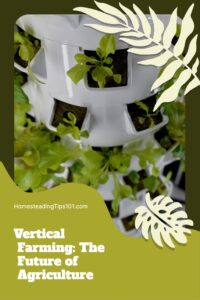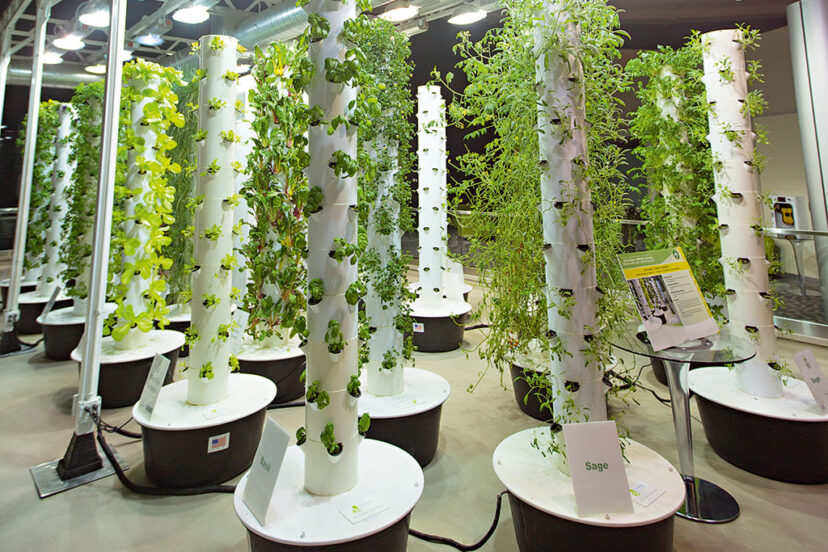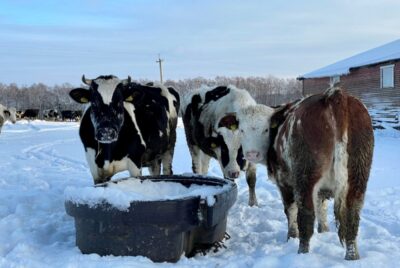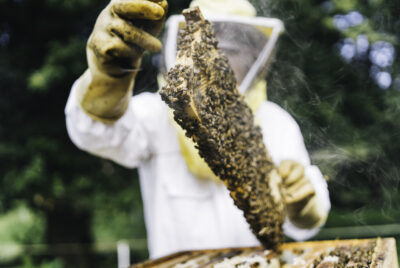Vertical Farming: The Future of Agriculture
"We may earn a commission from purchases made using our links. Please see disclaimer."
Introduction to Vertical Farming
What is Vertical Farming?
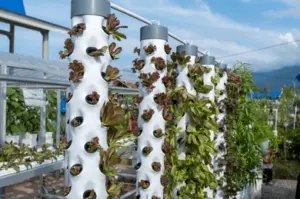 Hey there, fellow future farmer! I’m thrilled you’ve taken an interest in something as exciting as vertical farming. It’s like turning traditional farming on its side—literally! Imagine a farm that stretches upwards instead of spreading across acres of land. That’s what vertical farming is: growing plants in stacked layers, often integrated into urban buildings.
Hey there, fellow future farmer! I’m thrilled you’ve taken an interest in something as exciting as vertical farming. It’s like turning traditional farming on its side—literally! Imagine a farm that stretches upwards instead of spreading across acres of land. That’s what vertical farming is: growing plants in stacked layers, often integrated into urban buildings.
Vertical farming allows crops to be grown in a small footprint by stacking layers vertically. This method leverages technologies like hydroponics, aeroponics, LED lighting, and climate control to maximize crop yields. As available farmland decreases, vertical farming offers a sustainable solution to feed growing urban populations.
With techniques like hydroponics, aeroponics, aquaponics, and precision lighting, vertical farms can achieve yields over 100 times higher than traditional agriculture per acre. And by leveraging indoor conditions unaffected by climate, vertical farms can operate year-round, independent of seasons or weather.
Why is Vertical Farming Important?
 You might ask, “Why bother turning farms into skyscrapers?” Well, my friend, with the Earth’s population booming and arable land shrinking, we need innovative solutions to ensure everyone has enough food. By going vertical, we can grow more food in less space. Plus, it’s like giving a high-five to Mother Nature by reducing the carbon footprint of agriculture.
You might ask, “Why bother turning farms into skyscrapers?” Well, my friend, with the Earth’s population booming and arable land shrinking, we need innovative solutions to ensure everyone has enough food. By going vertical, we can grow more food in less space. Plus, it’s like giving a high-five to Mother Nature by reducing the carbon footprint of agriculture.
Vertical farming addresses critical issues like food security, sustainability, and self-sufficiency by enabling localized food production. Instead of crops being transported long distances, vertical farms can be built right in cities, dramatically reducing carbon emissions from transport. Urban vertical farming also conserves water, recycles nutrients, eliminates pesticides, and enhances food security for surrounding communities.
The Science Behind Vertical Farming
Hydroponics, Aeroponics, and Aquaponics
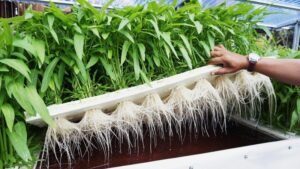 Vertical farming is a high-tech business, and here’s where the magic happens. Hydroponics lets plants grow in water-based, nutrient-rich solutions. No soil needed – it’s like a plant spa day, every day! Aeroponics takes it a step further, with plant roots suspended in air, and nutrients delivered via mist. And then there’s aquaponics – combining fish farming with hydroponics. It’s a harmonious cycle where the fish keep the plants happy, and the plants return the favor. Beautiful, isn’t it?
Vertical farming is a high-tech business, and here’s where the magic happens. Hydroponics lets plants grow in water-based, nutrient-rich solutions. No soil needed – it’s like a plant spa day, every day! Aeroponics takes it a step further, with plant roots suspended in air, and nutrients delivered via mist. And then there’s aquaponics – combining fish farming with hydroponics. It’s a harmonious cycle where the fish keep the plants happy, and the plants return the favor. Beautiful, isn’t it?
By leveraging technology like hydroponics, aeroponics, and aquaponics, vertical farms can precisely control nutrients, lighting, humidity, and other factors. This enables faster, year-round growth without traditional growing limitations from soil, weather, or seasons. Automated hydroponic and aeroponic systems continuously bathe roots in optimal nutrient solutions, facilitating rapid, robust plant development.
Artificial Lighting and Climate Control
LEDs and Their Role in Growth
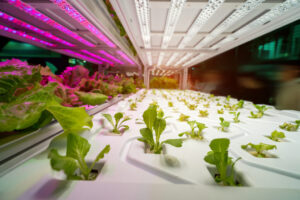 Sunlight is awesome, but what if we could create something even better for our plants? Enter LED lights. These energy-efficient glows are like sunshine on steroids, helping plants grow faster and healthier. Plus, with LEDs, you can grow crops year-round—talk about endless summer! LED lighting optimizes light wavelengths for photosynthesis, facilitating rapid, healthy plant growth. Combined with climate control technology, vertical farms can fine-tune temperature, humidity, and other conditions for each crop. This precision environment allows vertical farms to maximize yields and quality regardless of outdoor conditions.
Sunlight is awesome, but what if we could create something even better for our plants? Enter LED lights. These energy-efficient glows are like sunshine on steroids, helping plants grow faster and healthier. Plus, with LEDs, you can grow crops year-round—talk about endless summer! LED lighting optimizes light wavelengths for photosynthesis, facilitating rapid, healthy plant growth. Combined with climate control technology, vertical farms can fine-tune temperature, humidity, and other conditions for each crop. This precision environment allows vertical farms to maximize yields and quality regardless of outdoor conditions.
Benefits of Vertical Farming
Sustainability and Environmental Impact
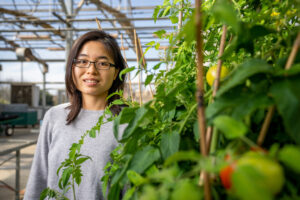 Imagine drastically reducing the need for deforestation and heavy water use. Vertical farming achieves that by being sustainable and eco-friendly. Fewer trees are cut down, and water gets recycled within the system. Mother Nature breathes a sigh of relief. With benefits like 90% less water usage and zero pesticides or transport emissions, vertical farming is far more eco-friendly than traditional agriculture. By recycling water and nutrients, leveraging renewable energy, and eliminating any need for land conversion, vertical farming is a uniquely sustainable method to supply cities with abundance.
Imagine drastically reducing the need for deforestation and heavy water use. Vertical farming achieves that by being sustainable and eco-friendly. Fewer trees are cut down, and water gets recycled within the system. Mother Nature breathes a sigh of relief. With benefits like 90% less water usage and zero pesticides or transport emissions, vertical farming is far more eco-friendly than traditional agriculture. By recycling water and nutrients, leveraging renewable energy, and eliminating any need for land conversion, vertical farming is a uniquely sustainable method to supply cities with abundance.
Year-Round Production
Rain or shine, snow or storm, your plants won’t care. They’ll be chilling in a controlled environment, producing fresh, delicious produce all year round.
By decoupling from seasonal and weather constraints, vertical farms can churn out bountiful harvests 365 days a year, no matter the climate. These highly predictable yields, immune to droughts or cold snaps, promise a transformative degree of food security.
Space-Efficiency
Got a small backyard or just a balcony? No worries! Vertical farming doesn’t discriminate. From small-scale setups to massive skyscraper farms, it’s like a TARDIS from Doctor Who – bigger on the inside. Unlike horizontal farming, vertical farming makes full use of vertical space, multiplying yield per square foot. A 30-story vertical farm equals nearly 500 acres of traditional farmland! Even apartment dwellers can enjoy fresh greens from compact indoor gardens.
Reduction in Transportation Costs

Wouldn’t it be nice if your food didn’t need a passport and a suitcase to reach your plate? With vertical farms in urban settings, your salad might just be your neighbor. Locating vertical farms in cities eliminates miles of transport from rural farms to urban grocers. This slashes fuel costs and results in fresher, tastier local produce. Because the produce is so local, it can be harvested ripe rather than early for transport and storage.
Challenges and Solutions
Initial Costs and Scaling
I won’t sugarcoat it—getting started with vertical farming can be pricey. But fear not! As with most technologies, costs are dropping. Plus, with the money you’ll save in the long run, your wallet will thank you.
Though vertical farming requires greater upfront investment, rapidly improving LED and automation tech are driving down costs. Government subsidies for urban agriculture could also accelerate financial viability. Faster growth cycles from precision agriculture allow vertical farms to reap more frequent harvests, improving cash flow.
Energy Consumption
Alternative Energy Sources
 Keeping those LED lights on can be energy-consuming. But, don’t fret! Solar panels, wind
Keeping those LED lights on can be energy-consuming. But, don’t fret! Solar panels, wind
turbines, or even biogas can be your farm’s best friends. Not only are you being a smart farmer but also a green energy advocate!
While lighting and climate control do consume energy, renewable energy integration and energy-efficient gear can offset much of the energy load. Government incentives for renewable energy projects and community solar programs can also help vertical farms achieve carbon-neutral operations.
Getting Started with Vertical Farming
In-depth Research
Before you jump into vertical farming, it’s wise to read up on the subject. Books, online courses, and webinars are great sources. If you’re an old-school type, local libraries might have some gems. Be a sponge and soak up all the knowledge you can. This will help you make informed decisions and avoid rookie mistakes.
Conducting thorough research helps determine optimal crops, technologies, and layouts for your particular climate and goals. Exploring case studies of successful vertical farms also provides invaluable insight into real-world opportunities and challenges. Don’t shy away from asking lots of questions early on.
Selecting Your Crops
Picking the right crops is a biggie. Some plants play well with vertical farming, while others might be a bit fussy. Start with easy-to-grow crops like lettuce, basil, or mint. Feeling adventurous? Try your hand at growing exotic herbs. Just imagine adding home-grown saffron to your dishes! When selecting crops, prioritize varieties that thrive under indoor controlled conditions and feature rapid grow cycles. This ensures efficient use of space and faster returns. Partner with local chefs to identify specialty greens and herbs with strong demand.
Technology Matters
 We talked about hydroponics and LEDs earlier, but let’s not forget about the monitoring systems. With advancements in tech, you can now control and monitor your farm from your smartphone. Talk about farming in the 21st century!
We talked about hydroponics and LEDs earlier, but let’s not forget about the monitoring systems. With advancements in tech, you can now control and monitor your farm from your smartphone. Talk about farming in the 21st century!
Flexible frameworks using off-the-shelf components simplify expansion and upgrades as innovative technologies emerge. Seek automation solutions providing real-time crop analytics to dial-in ideal growing parameters.
Budget and Financial Planning
It’s important to have a clear financial plan. Depending on the scale of your vertical farm, costs can vary. It’s like planning a road trip – you don’t want to run out of gas halfway there. Calculate costs, and potential profits, and have a buffer budget for unexpected expenses. Create detailed financial models factoring in system capabilities, crop choices, facility costs, energy needs, and target markets. Compare scenarios adjusting variables like crop prices and technology costs to guide planning.
Seeking Expert Advice
No man is an island, and no farmer should be either. Reach out to experts or experienced vertical farmers. Ask questions, seek advice, and maybe find a mentor. Remember, there’s no harm in asking.
Networking with vertical farming professionals provides valuable perspectives on deciding startup versus buy-in, partnerships, and potential funding sources. Don’t underestimate their first-hand wisdom.
Marketing Your Produce
 So you’ve grown these amazing, high-quality crops. Now what? Time to let the world know. Whether you’re selling to your neighbors or supplying to local stores, effective marketing is key. Emphasize the sustainability and quality of your produce. In the age of social media, a little online presence goes a long way.
So you’ve grown these amazing, high-quality crops. Now what? Time to let the world know. Whether you’re selling to your neighbors or supplying to local stores, effective marketing is key. Emphasize the sustainability and quality of your produce. In the age of social media, a little online presence goes a long way.
Research Indicates consumers show a willingness to pay premiums for pesticide-free, locally-grown produce. Promote your sustainability, transparency, and community ties.
Regular Maintenance
Your vertical farm is like a high-tech pet; it needs care and attention. Regularly check the pH levels, lighting, and nutrient solutions. Keep an eye out for pests and diseases. It’s like being a plant doctor and making sure your green patients are in tip-top shape. Prevent issues before they occur by establishing sensor-based monitoring and alerts for parameters like temperature, pH, moisture levels, etc. This enables quickly catching and resolving anomalies.
Conclusion
Vertical farming isn’t just agriculture; it’s a revolution. From its incredible space efficiency to its potential in changing the agricultural landscape, it’s truly transformative. By embracing vertical farming, you’re not just growing crops, but you’re also cultivating a brighter future for generations to come. So, what are you waiting for? Get growing!
FAQs
1. Can I start vertical farming at home?
Definitely! You can start small with shelves or a simple rack with grow lights and gradually expand. As your green thumb gets greener, you can invest in more advanced systems like hydroponics. It’s a great hobby and, who knows, it might even turn into a lucrative side gig!
2. What crops are best suited for vertical farming?
Leafy greens like lettuce and spinach are the superstars here, but don’t let that limit you. You can also grow strawberries, peppers, and even some root crops. Experiment with different plants and find what works best for your setup. Variety is the spice of life, right?
3. How much does it cost to start a vertical farm?
The scale of your ambition determines the size of your investment. A small setup can begin from a few hundred dollars, while a more commercial setup can run into thousands. Start small, learn the ropes, and as your farm flourishes, your investment can grow with it.
4. Is vertical farming organic?
Yes, it can be! By carefully controlling inputs, you can grow produce that is free from pesticides and qualifies as organic. However, keep in mind that achieving organic certification might require adhering to specific standards and regulations.
5. How can I learn more about vertical farming?
The internet is your oyster – forums, courses, and social media groups can be invaluable resources. Don’t forget the traditional route – books and journals. Stay curious and open to learning. Remember, even the experts were beginners once.
6. Is vertical farming profitable?
It certainly can be! With proper planning, quality control, and effective marketing, you can turn a neat profit. Moreover, as the demand for locally sourced, sustainable produce rises, vertical farming is set to become increasingly lucrative.
7. What is the average yield of a vertical farm?
It varies depending on the crops, but generally, vertical farms can have a yield that is over 10 times higher per square foot than traditional farming. Thanks to controlled environments and efficient resource use, these farms are like productivity powerhouses.
8. Can vertical farming feed the world?
Vertical farming has immense potential to contribute to global food production, especially in urban areas. While it might not replace traditional agriculture entirely, it can be a significant player in the fight against food shortages and sustainability challenges.
9. What are some common mistakes beginners make in vertical farming?
Common pitfalls include not doing enough research, underestimating costs, not monitoring crops closely, and being impatient for results. Like anything worth doing, vertical farming requires time, effort, and persistence. Be patient and learn from any mistakes you make along the way.
10. Can vertical farming be integrated into other businesses?
Absolutely! Think about a restaurant with its own vertical farm – talk about farm-to-table! Or a grocery store offering ultra-fresh produce grown on-site. Schools can also integrate vertical farming for educational purposes. The integration possibilities are as vast as your imagination.
